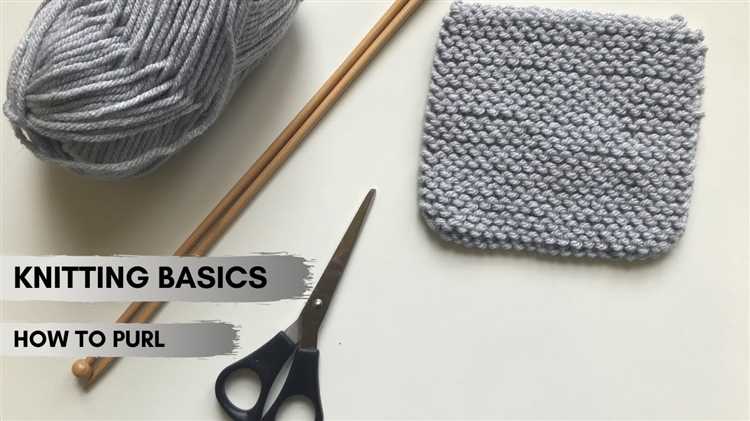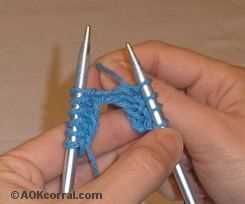If you are interested in learning how to knit, one of the first stitches you will need to learn is the purl stitch. The purl stitch is a basic knitting stitch that creates a raised loop on the front of your work, giving it a bumpy texture. It is often used in combination with the knit stitch to create various patterns and designs.
In this step-by-step guide, we will walk you through the process of knitting the purl stitch. We will start with the basic technique and then move on to more advanced variations. Whether you are a complete beginner or have some knitting experience, this guide will help you master the purl stitch and improve your knitting skills.
To knit the purl stitch, you will need a pair of knitting needles and some yarn. You can choose any type of yarn and needles that you feel comfortable with. It is important to start with a relatively smooth yarn and needles that are appropriate for the yarn weight. This will make it easier for you to see and manipulate the stitches.
Once you have your materials ready, we can begin learning how to knit the purl stitch. Follow the step-by-step instructions and practice as much as you need until you feel comfortable with the technique. Remember, knitting is a skill that improves with practice, so don’t be discouraged if it takes some time to get the hang of it!
What is knitting purl?
Knitting purl is a basic stitch used in knitting. It is the opposite of the knit stitch and creates a different texture on the fabric. While the knit stitch creates a smooth and flat texture, the purl stitch creates a bumpy and raised texture, often referred to as a “purl bump.”
Knitting purl is essential in creating various patterns and designs in knitting. It is commonly used in ribbing, seed stitch, garter stitch, and other patterns that require alternating between knit and purl stitches.
To create a purl stitch, the yarn is brought to the front of the work, inserted from the right to the left through the front loop of the stitch on the left needle, and then pulled through, creating a new stitch on the right needle.
The purl stitch is denoted in knitting patterns by the letter “p” or a symbol that represents a purl stitch. For example, if a pattern instructs you to “p2, k2” it means to purl 2 stitches and then knit 2 stitches, creating a ribbing pattern.
Learning how to knit purl is an essential skill for beginners. It opens up a world of possibilities in creating different textures and designs with just a simple stitch. With practice and patience, you’ll be able to master the purl stitch and confidently incorporate it into your knitting projects.
Benefits of Knitting Purl
Learning how to knit the purl stitch offers several benefits and opportunities for knitters. Whether you are a beginner or an experienced knitter, mastering the purl stitch can enhance your knitting skills and broaden your project options. Here are some benefits of knitting the purl stitch:
- Versatility: Knitting the purl stitch allows you to create a variety of different stitch patterns and textures in your knitting projects. By combining the purl stitch with other knitting stitches, such as the knit stitch, you can create intricate patterns and designs.
- Balance: Using the purl stitch in your knitting projects can help create balance and even tension in your fabric. Alternating between the knit stitch and the purl stitch can prevent your fabric from curling and give it a more stable structure.
- Reversible fabric: Knitting the purl stitch enables you to create reversible fabric, where both sides of your project look identical. This is particularly useful for items like scarves or blankets, where both sides may be visible. With the purl stitch, you can achieve beautiful texture and visual interest on both sides of your project.
- Countering stockinette stitch: Pairing the purl stitch with the knit stitch allows you to create the stockinette stitch, a common stitch pattern used in many knitting projects. The stockinette stitch creates smooth, V-shaped rows on the right side of the fabric and purl bumps on the wrong side.
- Expanding project options: Learning how to purl opens up a wide range of knitting project options. With the ability to use both the knit and purl stitches, you can create items such as scarves, hats, sweaters, socks, and more. The purl stitch also allows you to explore advanced knitting techniques, such as lace knitting and cable knitting.
Overall, mastering the purl stitch is beneficial for knitters of all levels. It adds versatility to your knitting repertoire, creates balanced fabric, offers reversible options, and opens up a world of project possibilities. So grab your needles, learn the purl stitch, and start knitting amazing creations!
Getting started with knitting purl
The purl stitch is an essential knitting stitch that creates a smooth and textured fabric. If you’re just getting started with knitting purl, here are some steps to help you master the technique:
- Hold the needles: Hold one knitting needle in your right hand and the other in your left hand. Make sure the point of the right needle is facing the left.
- Insert the right needle: Insert the point of the right needle into the first stitch on the left needle from right to left.
- Wrap the yarn: Take the yarn with your right hand and bring it to the front of the work, crossing it in front of the right needle.
- Wrap the yarn over the right needle: Take the yarn with your right hand and bring it over the right needle and towards the back of the work.
- Move the right needle downwards: Move the right needle downwards, behind the left needle, and through the stitch.
- Transfer the stitch: Slip the stitch off the left needle and onto the right needle.
- Tighten the yarn: Gently tighten the yarn to create an even tension.
- Repeat the steps: Repeat the steps for each stitch in the row until you reach the end of the row.
- Continue knitting: Once you’ve completed a row of purl stitches, you can continue knitting or switch to other knitting stitches to create different patterns and textures.
Remember, practice is key when learning how to knit purl. With time and patience, you’ll become more comfortable with the technique and be able to create beautiful purl stitch patterns.
Step 1: Casting on
Casting on is the first step in knitting and is the process of creating the first row of stitches on your knitting needle. This step is crucial as it determines the number of stitches you will have on your needle for your project.
Here are a few common methods for casting on:
-
Long-tail cast on: This is a popular method that creates a neat and stretchy edge. To do this:
- Make a slipknot and place it on the needle.
- Hold the needle with the slipknot in your right hand and the working yarn in your left hand.
- Insert the needle into the slipknot from left to right, creating a loop.
- With your left thumb and forefinger, pinch the loop that you just created.
- Bring the working yarn under the needle and back over your left thumb.
- Using the needle, go over and under the yarn on your thumb, creating a loop on the needle.
- Repeat steps 4-6 until you have the desired number of stitches.
-
Knitted cast on: This method is easy and creates a firm edge. To do this:
- Make a slipknot and place it on the needle.
- Hold the needle with the slipknot in your right hand and the working yarn in your left hand.
- Insert the right needle into the slipknot stitch from left to right, as if to knit.
- Wrap the yarn around the right needle counterclockwise.
- Draw the loop of yarn through the slipknot stitch, creating a new stitch on the right needle.
- Repeat steps 3-5 until you have the desired number of stitches.
-
Backward loop cast on: This method is quick and easy, but may not be as secure. To do this:
- Hold the working yarn in your right hand.
- Create a loop with the yarn, crossing it over itself.
- Place the loop onto the left needle.
- Repeat steps 2-3 until you have the desired number of stitches.
These are just a few of the many casting on methods available. Choose the one that works best for your project and practice until you feel comfortable with it. Now you’re ready to move on to the next step in knitting!
Step 2: Knitting the first row
Now that you have casted on your stitches, let’s move on to knitting the first row. This step will help you get started with the basic knit stitch.
Before you start knitting, make sure you have the working yarn attached to the back needle, and the empty needle in your right hand. You are ready to begin!
- Hold the knitting needles in both hands, with the left hand holding the needle with the casted-on stitches and the right hand holding the empty needle.
- Insert the right-hand needle into the first stitch on the left-hand needle, going from front to back.
- Wrap the working yarn around the right-hand needle, going from back to front.
- Using the right-hand needle, pull the yarn through the first stitch, creating a new stitch on the right-hand needle.
Repeat steps 2-4 until you have worked across all the stitches on the left-hand needle. This will complete the first row of knit stitches.
Remember to keep your tension relaxed and even as you knit each stitch. Practice this step until you feel comfortable with the motion and rhythm of knitting.
Once you have completed knitting the first row, you can move on to the next step and learn how to purl, or continue knitting additional rows in the knit stitch.
Step 3: Purling the second row
After completing the first row of knitting, it’s time to move on to the second row and learn how to purl. Purling is the opposite of knitting and creates a different texture in your knitting project.
To start purling, follow these steps:
- Hold the knitting needles with the first row of stitches in your left hand.
- Insert the right knitting needle into the first stitch on the left knitting needle from right to left.
- Take the working yarn, which should be in the front of your work, and wrap it counterclockwise around the right knitting needle.
- Use the right knitting needle to pull the loop of yarn through the stitch on the left knitting needle.
- Slide the stitch off the left knitting needle and onto the right knitting needle.
- Repeat these steps for the remaining stitches in the row.
Remember to keep your tension even and not too tight or too loose as you purl. Practice purling several rows until you feel comfortable with the technique.
Purling is an essential skill in knitting, as it allows you to create different stitch patterns and textures in your projects. Once you have mastered the purl stitch, you can combine it with knitting to create a wide variety of patterns.
Now that you have completed the second row by purling, continue alternating between knitting and purling for subsequent rows to create your desired pattern or design.
Step 4: Repeat and practice
Now that you have learned how to knit and purl, it’s time to repeat and practice these stitches. Like any new skill, knitting requires practice and repetition to become proficient. By practicing regularly, you will improve your technique and gain confidence in your knitting abilities.
Here are some tips to help you make the most of your practice sessions:
- Start with a small project: Choose a simple pattern or project to start with, such as a scarf or a dishcloth. This will allow you to practice your knitting and purling in a manageable way, without overwhelming yourself with a complex project.
- Set aside regular practice time: Make a commitment to practice knitting regularly. Set aside dedicated time each day or week to work on your knitting skills. Consistency is key to improving your technique.
- Focus on technique: Pay attention to your technique as you practice. Make sure you are holding your needles and yarn correctly and that your tension is consistent. If you have difficulty with a particular stitch or technique, take the time to practice it separately until you feel comfortable with it.
- Don’t be afraid to make mistakes: Mistakes are a natural part of learning. Embrace them and view them as opportunities to learn and grow. If you make a mistake, try to identify what went wrong and how you can improve for next time.
Remember, knitting is a skill that takes time and patience to master. Don’t get discouraged if your first few projects don’t turn out perfectly. Keep practicing and you will improve with time.
By repeating and practicing your knitting and purling stitches, you will become more comfortable and confident in your abilities. Soon, you’ll be able to tackle more complex patterns and projects. So keep practicing and enjoy the process of learning this beautiful craft!
FAQ:
What is the difference between knitting and purling?
Knitting and purling are two basic stitches in knitting. The main difference between them is how the yarn is wrapped around the needle. In knitting, the yarn is held in the back of the work, while in purling, the yarn is held in the front of the work. Knitting creates a “knit” stitch, which looks like a little V, while purling creates a “purl” stitch, which looks like a little bump.
Why is it important to learn how to purl?
Learning how to purl is important because it expands your knitting skills and allows you to create different patterns and textures in your knitting. Purl stitches are often used in combination with knit stitches to create ribbing, stockinette stitch, and other popular knitting patterns. By learning how to purl, you can add more variety and interest to your knitting projects.
How do I hold the yarn when purling?
When purling, you hold the yarn in your left hand. Take the working yarn and bring it to the front of the work between the two needles. Then, insert the right needle into the stitch on the left needle from right to left, with the yarn in front. Wrap the yarn around the right needle counterclockwise, then pull it through the stitch, sliding the old stitch off the left needle. Repeat these steps for each purl stitch.
Can I only knit purl stitches?
No, knitting is not limited to purl stitches only. Knitting involves a combination of both knit and purl stitches to create a variety of patterns and textures. While purl stitches are essential for certain patterns, it’s important to learn both knit and purl stitches in order to become a versatile knitter. By knowing both stitches, you’ll be able to follow different knitting patterns and create a wide range of knitted items.


